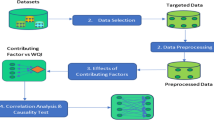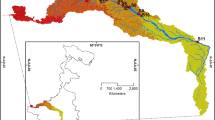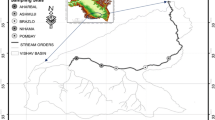Abstract
Change of water quality in dam reservoir and aquifer complicates safe drinking water supply. Few parameters are monitored to control water quality in these sources. Adequate knowledge on the correlation structure, interaction effect, trends and seasonal variability of these parameters is essential to control water quality. This study applied time series and multivariate analyses on 15 water quality parameters, collected from the King Fahd dam reservoir (L1) and aquifer (L2) in Saudi Arabia during April 2010 to February 2012. Moderate to strong correlations were observed between sulfate, hardness, fluoride, chloride, magnesium, conductivity, turbidity and total dissolved solids (TDS), while separate clusters were visible for TDS-chloride-magnesium-conductivity; fluoride-turbidity; chloride-hardness; ammonia-nitrate; and calcium-magnesium-hardness. Four major principal components explained 81.1 % and 83.2 % of the overall variances in L1 and L2, respectively. The factor analysis showed that 53 % and 67 % of the data were necessary to explain 81.3 % and 83.2 % of total variances for L1 and L2, respectively, indicating the possibility of data reduction. Possible degradation of water quality in these sources was highlighted, while such degradation may require enhanced treatment for producing drinking water in future.






Similar content being viewed by others
References
Abdul-Wahab, S. A., Bakheit, C. S., & Al-Alawi, S. M. (2005). Principal component and multiple regression analysis in modelling of ground-level ozone and parameters affecting its concentrations. Environmental Modelling & Software, 20(10), 1263–1271.
Adams, S., Titus, R., Pietesen, K., Tredoux, G., & Harris, C. (2001). Hydrochemical characteristic of aquifers near Sutherland in the Western Karoo, South Africa. Journal of Hydrology, 241, 91–103.
Bengrane, K., & Marhaba, T. F. (2003). Using principal component analysis to monitor spatial and temporal changes in water quality. Journal of Hazardous Materials, 100, 179–195.
Bricker, O. P., & Jones, B. F. (1995). Main parameters affecting the composition of natural waters. In B. Salbu & E. Steinnes (Eds.), Trace elements in natural waters (pp. 1–5). Boca Raton: CRC Press.
Brumelis, G., Lapina, L., Nikodemus, O., & Tabors, G. (2000). Use of an artificial model of monitoring data to aid interpretation of principal component analysis. Environmental Modelling & Software, 15(8), 755–763.
Carpenter, S. R., Caraco, N. F., Correll, D. L., Howarth, R. W., Sharpley, A. N., & Smith, V. H. (1998). Nonpoint pollution of surface waters with phosphorus and nitrogen. Ecological Applications, 83, 559–568.
Chowdhury, S., & Al-Zahrani, M. (2013). Characterizing water resources and the trends of sector wise water consumptions in Saudi Arabia. Journal of King Saud University–Engineering Sciences. doi:10.1016/j.jksues.2013.02.002.
Chowdhury, S., Champagne, P., & Husain, T. (2007). Fuzzy risk-based decision-making approach for selection of drinking water disinfectants. Journal of Water Supply Research and Technology, 56(2), 75–93.
Chowdhury, S., Champagne, P., & McLellan, P. J. (2008). Parameters influencing formation of Trihalomethanes in drinking water: results from multivariate statistical investigation of the Ontario Drinking Water Surveillance Program database. Water Quality Research Journal of Canada, 43(2/3), 189–199.
Dixon, W., & Chiswell, B. (1996). Review of aquatic monitoring program design. Water Research, 30, 1935–1948.
Evans, C. D., Monteith, D. T., & Cooper, D. M. (2005). Long-term increases in surface water dissolved organic carbon: observations, possible causes and environmental impacts. Environmental Pollution, 137, 55–71.
HACH 2012. The list if parameters and methods. Available at: http://www.hach.com/browse.by.parameter-list.jsa.
Helena, B., Pardo, R., Vega, M., Barrado, E., Fernandez, J. M., & Fernandez, L. (2000). Temporal evolution of groundwater composition in an alluvial aquifer (Pisuerga River, Spain) by principal component analysis. Water Research, 34, 807–816.
Hon, R., Constantin, A., Xian, Q. 2006. Statistical analysis of surface water quality data of eastern Massachusetts. 2006 Philadelphia Annual Meeting, Paper No: 179–9.
Jackson, J. E. (1991). A user guide to principal components. New York, USA: John Wiley and Sons.
Jarvie, H. P., Whitton, B. A., & Neal, C. (1998). Nitrogen and phosphorus in east-coast British rivers: speciation, sources and biological significance. Science of the Total Environment, 210(211), 79–109.
Lee, J. Y., Cheon, J. Y., Lee, K. K., Lee, S. Y., & Lee, M. H. (2001). Statistical evaluation of geochemical parameter distribution in a ground water system contaminated with petroleum hydrocarbons. Journal of Environmental Quality, 30, 1548–1563.
Liu, C. W., Lin, K. H., & Kuo, Y. M. (2003). Application of factor analysis in the assessment of groundwater quality in a blackfoot disease area in Taiwan. Science of the Total Environment, 313, 77–89.
Love, D., Hallbauer, D., Amos, A., & Hranova, R. (2004). Factor analysis as a tool in groundwater quality management: two southern African case studies. Physics and Chemistry of the Earth, 29, 1135–1143.
MOEP (The Ministry of Economy and Planning) (2010) The Ninth Development Plan (2010–2014), The Kingdom of Saudi Arabia.
Monteith, D. T., Stoddard, J. L., Evans, C. D., de Wit, H. A., Forsius, M., Høgasen, T., et al. (2007). Dissolved organic carbon trends resulting from changes in atmospheric deposition chemistry. Nature, 450, 537–541. doi:10.1038/nature06316.
MOWE (Ministry of Water and Electricity) (2011) Kingdom of Saudi Arabia: dams. Available at: http://intranet.mowe.gov.sa/Dams/.
Mrklas, O., Bentley, L., Lunn, S., & Chu, A. (2006). Principal Component Analyses of groundwater chemistry data during enhanced bioremediation. Water, Air, and Soil Pollution, 169, 395–411.
Prathumratana, L., Sthiannopkao, S., & Kim, K. W. (2008). The relationship of climatic and hydrological parameters to surface water quality in the lower Mekong River. Environment International, 34, 860–866.
Praus, P. (2005). Water quality assessment using SVD-based principal component analysis of hydrological data. Water SA, 31(4) (Online version).
Qadir, A., Malik, R. N., & Husain, S. Z. (2007). Spatio–temporal variations in water quality of Nullah Aik-tributary of the river Chenab, Pakistan. Environmental Monitoring and Assessment, 140, 43–59.
Rao, S. N., Devadas, D. J., & Rao, K. V. S. (2006). Interpretation of groundwater quality using principal component analysis from Anantapur district, Andhra Pradesh, India. Environmental Geosciences, 13, 239–259.
Reghunath, R., Murthy, T. R. S., & Raghavan, B. R. (2002). The utility of multivariate statistical techniques in hydrogeochemical studies: an example from Karnataka, India. Water Research, 36, 2437–2442.
Shrestha, S., & Kazama, F. (2007). Assessment of surface water quality using multivariate statistical techniques: a case study of the Fuji River basin, Japan. Environmental Modelling and Software, 22, 464–475.
Simeonov, V., Stratis, J. A., Samara, C., Zachariadis, G., Voutsa, D., Anthemidis, A., et al. (2003). Assessment of the surface water quality in Northern Greece. Water Research, 37, 4119–4124.
Simeonov, V., Simeonova, P., & Tsitouridou, R. (2004). Chemometric quality assessment of surface waters: two case studies. Chemical and Engineering Ecology, 11(6), 449–469.
Simeonova, P., Simeonov, V., & Andreev, G. (2003). Environmetric analysis of the Struma River water quality. Central European Journal of Chemistry, 2, 121–126.
Singh, K. P., Malik, A., Mohan, D., & Sinha, S. (2004). Multivariate statistical techniques for the evaluation of spatial and temporal variations in water quality of Gomti River (India): a case study. Water Research, 38, 3980–3992.
Singh, K. P., Malik, A., & Sinha, S. (2005). Water quality assessment and apportionment of pollution sources of Gomti River (India) using multivariate statistical techniques: a case study. Analytica Chimica Acta, 538, 355–374.
Smith, L. I. (2002). A tutorial on Principal component analysis (Access online on Oct 22, 2007). Available from: http://www.cs.otago.ac.nz/cosc453/student_tutorials/principal_components.pdf.
Varol, M., & Şen, B. (2009). Assessment of surface water quality using multivariate statistical techniques: a case study of Behrimaz Stream, Turkey. Environmental Monitoring and Assessment, 159, 543–553.
Varol, M., Gökot, B., Bekleyen, A., & Şen, B. (2012). Spatial and temporal variations in surface water quality of the dam reservoirs in the Tigris River basin, Turkey. Catena, 92, 11–21.
Vega, M., Pardo, R., Barrado, E., & Deban, L. (1998). Assessment of seasonal and polluting effects on the quality of river water by exploratory data analysis. Water Research, 32, 3581–3592.
WHO. (2011). Guidelines for drinking water quality (4th ed.). Geneva: World Health Organization.
Wold, S., Esbensen, K., & Geladi, P. (1987). Principal component analysis. Chemometrics and Intelligent Laboratory Systems, 2, 37–52.
Wunderlin, D. A., Diaz, M. P., Ame, M. V., Pesce, S. F., Hued, A. C., & Bistoni, M. A. (2001). Pattern recognition techniques for the evaluation of spatial and temporal variations in water quality. A case study: Suquia River basin (Cordoba, Argentina). Water Research, 35, 2881–2894.
Acknowledgments
The authors would like to acknowledge the support provided by the Deanship of Scientific Research (DSR) at King Fahd University of Petroleum & Minerals (KFUPM) for funding this work through project No. RG 1118-1 and RG 1118-2. The assistance of Bisha dam authority to obtain the data is greatly acknowledged.
Author information
Authors and Affiliations
Corresponding author
Rights and permissions
About this article
Cite this article
Chowdhury, S., Al-Zahrani, M. Water quality change in dam reservoir and shallow aquifer: analysis on trend, seasonal variability and data reduction. Environ Monit Assess 186, 6127–6143 (2014). https://doi.org/10.1007/s10661-014-3844-0
Received:
Accepted:
Published:
Issue Date:
DOI: https://doi.org/10.1007/s10661-014-3844-0




